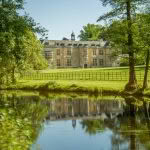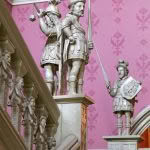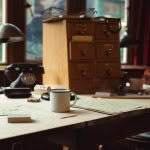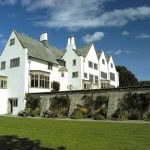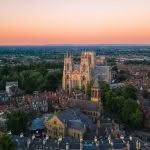Lessons in history
A trip to Britain is always a history lesson. Here, we visit some special and varied gems – from historic houses to the charming city of York, an Arts and Crafts architectural masterpiece and a wee Fife fishing village. If you want to experience where a queen slept, walk ancient city walls, or ‘decipher’ the Second World War, read on …
Words Sara Faull
- Photos courtesy of Hartwell House & Spa – Historic House Hotels.
- Photos courtesy of Hartwell House & Spa – Historic House Hotels.
- Photos courtesy of Hartwell House & Spa – Historic House Hotels.
- Photos courtesy of Hartwell House & Spa – Historic House Hotels.
- Photos courtesy of Hartwell House & Spa – Historic House Hotels.
An Historic House Hotel and Spa
If you have always wanted to stay in one of Britain’s finest stately homes, then the Grade I listed, part Jacobean/part Georgian mansion that is now Hartwell House Hotel is a luxurious option. Today, a National Trust treasure, the house is surrounded by 90 acres of parkland and is situated near Aylesbury in Buckinghamshire, about 60 kilometres north-west of London.
It is also a house with a history that spans nearly 1,000 years, dating back to the bastard son of William the Conqueror and the Domesday Book of 1086. Royal connections are many – most notably King Louis XVIII of France, who in 1809 (after the French Revolution) brought his queen and his court to Hartwell and lived there for five years, even converting the roof into a miniature farm. Over the centuries, owners have included the most illustrious of families, at least one knight of the realm, a teetotaller and even a millionaire recluse. During World War II, the house was used as an army billet and in 1956 until 1983, it was leased out as a secretarial college. This is when I came to know Hartwell House, where I and many others spent several terms learning shorthand and typing in its (by then rather shabby, if still beautifully proportioned) rooms. Such is the ignorance of youth that we raced up and down the dark Jacobean staircase without any respect for its fine lineage and I remember gunning my little orange mini over ancient stone bridges and around its verdant grounds.
Now that the house has been lavishly restored by Historic House Hotels, my fellow Hartwell House friend, Jo Lennon and I were keen to revisit this remarkable house. This time we stopped to admire the Georgian interiors. We stood proudly on the Jacobean staircase with its fine carvings. We sat demurely on the plush silk sofas, surrounded by intricate Rococo flourishes and reminisced about what used to be where.
Hartwell House is known for its superb High Teas and I must say, ours was as sumptuous and dainty as you could wish for.
- Photos courtesy of Bletchley Park Trust.
- Photos courtesy of Bletchley Park Trust.
- Photos courtesy of Bletchley Park Trust.
Codebreakers of Bletchley Park
My friend Jo was also keen to visit Bletchley Park near Milton Keynes in Buckinghamshire, which is about 80 kilometres north-west of London. Bletchley was once the top secret home of the World War II codebreakers and is now an independent museum and award-winning heritage attraction. Tickets cost around £20 but are valid for a year, and since a typical visit lasts between four and five hours, it may take several visits to appreciate the scale and complexity of what happened here.
In the original pink brick Victorian mansion that is the centrepiece of the park, Commander Denniston’s office and library have been reinstated as they were in wartime. The heavy rotary phone sits squatly on a desk. A secretary’s jacket cloaks the back of a chair – her upright leather bag waiting demurely on the floor by the wastepaper basket. Visitors can view the garages where top secret intelligence was transported, the stable yard where the first British ‘breaks’ were made into the German military cipher machines, and visit the many concrete huts that surround the mansion.
There are blocks showing restored war codebreaking techniques, the Bombe machines developed by Alan Turing and Gordon Welchman, and even a Teleprinter Building, explaining Bletchley Park’s role in planning the D-Day operations. Maps, films, files, recordings of personal stories – all the details of how Bletchley Park operated with a workforce of around 9,000 at its peak.
Even though I have seen the movies Operation Mincemeat and The Imitation Game, I had no idea of what to expect from a visit to such an attraction. The experience was humbling, moving and illuminating in equal measure. I shall never forget it. Our free tour by a voluntary and most passionate local guide was an added bonus. The park is extensive but there are shops, conveniences and a café. You can have a casual picnic on the lawn or book a genteel afternoon tea in the mansion.
- Photos courtesy of Blackwell House.
- Photos courtesy of Blackwell House.
- Photos courtesy of Blackwell House.
- Photos courtesy of Blackwell House.
Arts and Crafts Masterpiece
While we were staying with whānau in the Lake District, our hosts were keen to show us one of the finest Arts and Crafts houses in Britain. Blackwell House, which overlooks Lake Windermere, was designed by architect and interior designer Mackay Hugh Baillie Scott as a holiday home for the wealthy Manchester brewer, Sir Edward Holt, his wife Elizabeth and their five children. It eventually became a school.
Opened to the public in 2001, Blackwell House remains the most important surviving house by one of the most influential architects and designers of the early 20th century. Like others in the Arts and Crafts Movement such as John Ruskin and William Morris, Baillie Scott was passionate about keeping traditional craftsmanship alive during the early days of mass production. While factories in towns like High Wycombe were churning out 4,700 chairs per day in 1875, Baillie Scott preferred the ‘imperfect efforts of the hand of man’.
What is astonishing, even now, is that the structure and design of the building was also a template for all the interior fittings. Baillie Scott sited the house for light and relaxed living, which gives some of the rooms, such as the White Drawing Room, a fresh, modern feel. Also of note is the minute attention given to every detail, from the door handles and Inglenook fireplaces, to the hand-carved woodwork and stained glass repeated throughout.
In keeping with the Arts and Crafts theme, various pieces of furniture have either been gifted or are on loan and the vibrant, geometric works of potter and ceramicist William de Morgan are also on display.

Pittenweem
When the family we were staying with in Scotland learned that we enjoyed art, they delighted in taking us to the tiny fishing village of Pittenweem in Fife on the east coast of Scotland. Boasting only a few thousand residents, this port of trawlers and tiny cottages welcomes over 25,000 visitors when it hosts its annual Pittenweem Arts Festival every August. What makes this creative display unique is that the exhibits (by over 140 contributing artists) are showcased throughout the port – in low-ceilinged holiday cottages vacated for the duration, homes, studios, and repurposed sheds and garages. The bunting is waving its welcome, the hanging baskets are refreshed and the entire village seems to get involved.
The festival prides itself on celebrating ‘the joy of art in everyday spaces, making it accessible and relatable’ the programme says. It is a chance to chat to artists, gain an insight into the creative process or simply buy a piece of art. And art in all its glory is what we got to see – from meticulously crafted, large-scale quilts to vessels in porcelain, stoneware and glass. Prints, jewellery and landscapes of sheerest watercolour to canvases adorned with rubber and collage, acrylic, pastel and gouache. From the abstract to the hyper-real, from the amateur to the experienced artist, this tiny port town welcomed us all.
- Photos Jake Eastham.
- Photos Jake Eastham.
- Photos Jake Eastham.
- Photos Jake Eastham.
THIS LITTLE PIGGY WENT TO MARKET
Perhaps only one of Britain’s most successful hoteliers – Robin Hutson – would opt to call his latest chain of nine hotels around the south coast of England The Pig Hotel Group, but a family friend in Kent was very keen for us to visit this ‘new’ style of immersive country hotel experience.
Taking shabby, run-down relics of buildings, Britain’s Robin and Judy Hutson are renowned for sumptuous yet unpretentious interior design makeovers that maximise the original features. Their immersive country hotels use simple, home-cooked food harvested from each hotel’s extensive kitchen garden or sourced from local suppliers and producers. The menus in all nine establishments follow a 25-mile rule.
From the chain’s ‘golden’ pig at the gate, to the stone pigs at the entrance announcing ‘no piggybacks’ and the line-up of wellies guarding the entrance stairs, the interiors are a clever combination of luxury, wit and seriously attentive service.
The Pig at Bridge Place opened in 2019 with 29 rooms. The original brick house is 17th century, with a vivid, convivial backstory, including rejuvenating itself in the sixties as Kent’s foremost rock ’n’ roll club venue. We popped in to have a look and ordered coffees, served in one of the lounges with low ceilings and exposed beams. Only an hour by fast train from London and with its emphasis on comfort and sustainability, The Pig Hotel Group’s ethos is appealing to the ‘Down From London’ weekend market and bringing much-needed business and tourism to the south coast. We certainly ogled the beautiful young wandering around with their babies, boyfriends and besties, enjoying the country vibes without the upkeep. Happy as a Pig in Mud!
- Photos courtesy of Visit York.
- Photos courtesy of Visit York.
- Photos courtesy of Visit York.
York – The Walled City
Central to the largest county in England and renowned for its minster, I have always wanted to visit York – the walled city in north-east England founded by the Romans, fought over by the Vikings and emboldened by Victorian railways. Since York was a settlement halfway between London and Edinburgh, it was historically central to the King (or Queen’s) business and its history is as rich and gory as Britain’s itself.
A must-see, of course, is York Minster, which is not a relic but a working church, that has suffered at least five fires ignited by candle inattention, arson and a lightning strike. While there is no fee for York citizens, it costs £18 for visitors to enter. Over 400 volunteers offer their services as it takes £37,000 per day to keep the cathedral functioning.
When you have had your fill of stained glass and gilt, saints and sinners, you can always walk the ancient walls, stroll down the Shambles street, shop the independent retailers, try your hand at chocolate making or take a cruise down the River Ouse. There is the Jorvik Viking Centre and the National Railway Museum to explore; and the two-hundred-year-old National Gallery, with one of the most important collections of British studio ceramics, is well worth a visit. Check opening times as galleries and museums outside London are often closed early in the week.
We stayed in the Grade II listed Royal Station Hotel (now the Principal) which had gorgeous late-Victorian features like an intricate iron staircase and was later furnished in the Art Deco style.



